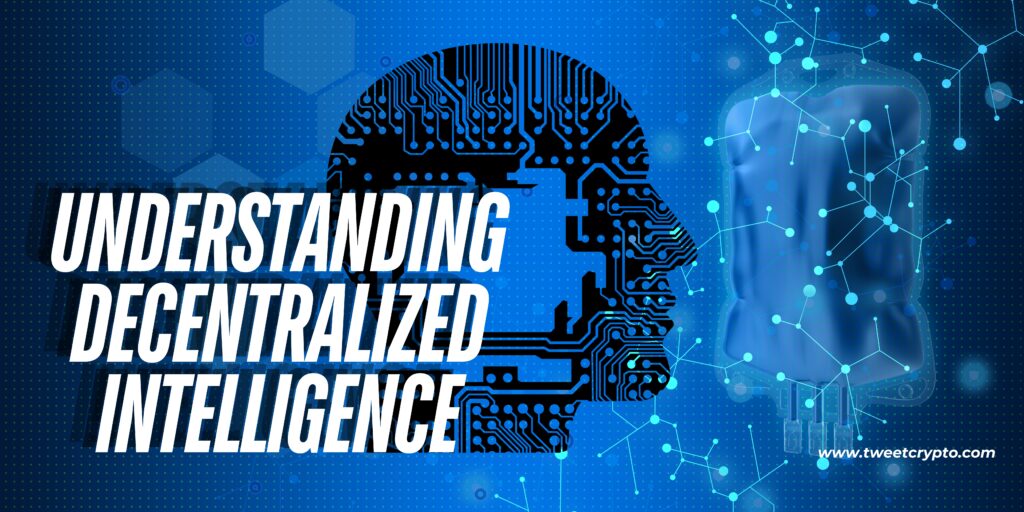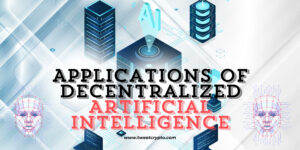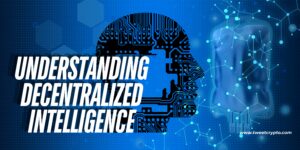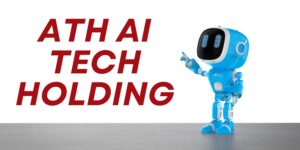Unlocking the Future of AI: How Blockchain and GPUs are Powering Decentralized Intelligence

Yo Crypto Fam, buckle up for a mind-blowing ride into the future of artificial intelligence! We’re all familiar with the hype surrounding Artificial Intelligence self-driving cars, intelligent assistants, and maybe even that creepy robot dog that just showed up on your neighbor’s lawn. But what if I told you the real revolution in artificial intelligence isn’t just about what it can do, but how it’s built? That’s where Decentralized Intelligence (DI) comes in, and it’s about to change the game.
Outline
-
Introduction
– Welcome and Hook
– Overview of Artificial Intelligence and DI
-
Understanding Decentralized Intelligence
– Definition of Decentralized Intelligence
– Comparison with Traditional artificial intelligence
-
The Role of GPUs in Artificial Intelligence
– What are GPUs?
– Importance of GPUs in artificial intelligence
– Decentralized Contribution of GPUs
-
Blockchain: The Trust Machine
– What is Blockchain?
– How Blockchain Ensures Transparency in artificial intelligence
– Real-world Examples
-
Combining Blockchain and GPUs
– Synergy between GPUs and Blockchain
– Benefits of Decentralized Artificial Intelligence
-
Applications of Decentralized Artificial Intelligence
– Healthcare
– Finance
– Transportation
– Scientific Research
-
Challenges and Considerations
– Technical Challenges
– Ethical Considerations
– Regulatory Landscape
-
The Future of Decentralized Artificial Intelligence
– Potential Developments
– Long-term Impact on Society
-
Conclusion
– Recap of Key Points
– Call to Action
-
FAQs
– What is Decentralized Intelligence?
– How do GPUs contribute to artificial intelligence?
– Why is blockchain important for Artificial Intelligence?
– What are some real-world applications of Decentralized artificial intelligence?
– What are the challenges of implementing Decentralized artificial intelligence?
Introduction
Yo Crypto Fam, buckle up for a mind-blowing ride into the future of artificial intelligence! We’re all familiar with the hype surrounding Artificial Intelligence self-driving cars, intelligent assistants, and maybe even that creepy robot dog that just showed up on your neighbor’s lawn. But what if I told you the real revolution in artificial intelligence isn’t just about what it can do, but how it’s built? That’s where Decentralized Intelligence (DI) comes in, and it’s about to change the game.
Understanding Decentralized Intelligence
Definition of Decentralized Intelligence
Imagine artificial intelligence that’s not controlled by a single corporation but distributed across a network of computers, just like your favorite cryptocurrency. That’s the core idea behind Decentralized Intelligence (DI). DI leverages the power of collective resources, ensuring that artificial intelligence development and usage are democratized.
Comparison with Traditional Artificial Intelligence
Traditional artificial intelligence systems are typically centralized, relying on vast amounts of data and processing power housed within the servers of tech giants like Google, Amazon, or Facebook. In contrast, DI spreads this power across a network, allowing anyone with the right hardware to contribute. This decentralization not only democratizes access but also enhances transparency and security.
The Role of GPUs in Artificial Intelligence
What are GPUs?
Think of a GPU (Graphics Processing Unit) as the muscle behind artificial intelligence. Unlike regular CPUs, GPUs are designed to handle thousands of simultaneous computations, making them perfect for the heavy lifting required in artificial intelligence processes.
Importance of GPUs in Artificial Intelligence
GPUs are like supercharged calculators that can crunch through massive datasets – the fuel that powers artificial intelligence learning. Whether it’s training complex neural networks or processing large volumes of data, GPUs are essential for making artificial intelligence run efficiently.
Decentralized Contribution of GPUs
In a decentralized system, anyone with a powerful GPU could contribute processing power to the artificial intelligence network, kind of like how miners contribute computing power to secure a blockchain. This not only democratizes artificial intelligence development but also provides an incentive for individuals to participate.
Blockchain: The Trust Machine
What is Blockchain?
Blockchain is a decentralized ledger technology that ensures data integrity and transparency. Each transaction or data entry is recorded in a block and linked to the previous one, forming a chain that is nearly impossible to alter.
How Blockchain Ensures Transparency in Artificial Intelligence
Remember that feeling of unease when some corporation claims their artificial intelligence is the best and most unbiased? Yeah, me too. Blockchain solves this by providing a transparent and secure way to track the training data and development of the artificial intelligence model. Everyone on the network can see what data is being used and how the artificial intelligence is evolving, fostering trust and preventing bias.
Real-world Examples
A decentralized artificial intelligence for predicting stock prices could leverage blockchain to ensure all the financial data used for training is verifiable and hasn’t been tampered with. This transparency builds trust among users and prevents the artificial intelligence from being biased towards certain financial institutions.
Read more on : Ankr
Combining Blockchain and GPUs
Synergy between GPUs and Blockchain
Combining the power of GPUs with the security and transparency of blockchain creates a robust framework for decentralized artificial intelligence. GPUs provide the computational power needed to train and run artificial intelligence models, while blockchain ensures that the data and processes are transparent and secure.
Benefits of Decentralized Artificial Intelligence
Distributing artificial intelligence across a network unlocks a whole new level of potential. By combining the processing power of multiple GPUs and the secure data management of blockchain, decentralized artificial intelligence can tackle problems that would be impossible for any single entity. Imagine a network of artificial intelligence models working together to develop new drugs, optimize traffic flow in a city, or even create groundbreaking scientific discoveries – the possibilities are endless!
Applications of Decentralized Artificial Intelligence

Healthcare
A decentralized artificial intelligence network for medical research could leverage the combined power of multiple GPUs to analyze vast datasets of medical scans and patient data. This could lead to faster breakthroughs in disease diagnosis and personalized treatment plans.
Finance
In finance, decentralized artificial intelligence could be used to analyze market trends, predict stock prices, and manage investment portfolios, all while ensuring transparency and reducing the risk of bias.
Transportation
Optimizing traffic flow in cities, managing public transportation systems, and even developing autonomous vehicles could all benefit from decentralized artificial intelligence, making our commutes smoother and more efficient.
Scientific Research
Decentralized artificial intelligence could revolutionize scientific research by allowing researchers to collaborate on large-scale projects, analyze massive datasets, and develop new theories and technologies more quickly.
Read more on : Medium
Challenges and Considerations
Technical Challenges
Building and maintaining a decentralized artificial intelligence network comes with significant technical challenges. Ensuring compatibility between different systems, maintaining data integrity, and optimizing network performance are just a few of the hurdles that need to be overcome.
Ethical Considerations
As with any Artificial Intelligence development, ethical considerations are paramount. Ensuring that decentralized Artificial Intelligence is used responsibly, protecting user data, and preventing misuse are critical components of its development.
Check out : Tweet Crypto
Regulatory Landscape
The regulatory landscape for decentralized Artificial Intelligence is still evolving. Governments and regulatory bodies need to develop frameworks that encourage innovation while protecting the interests of users and society at large.
The Future of Decentralized Artificial Intelligence
Potential Developments
The potential developments in decentralized artificial intelligence are vast. From more efficient and transparent artificial intelligence systems to new applications we haven’t even dreamed of yet, the future is bright for this technology.
Long-term Impact on Society
In the long term, decentralized artificial intelligence could have profound impacts on society. By democratizing access to artificial intelligence technology, we can ensure that its benefits are distributed more evenly and that everyone has a say in its development and use.
Conclusion
Decentralized artificial intelligence is still in its early stages, but the potential is mind-blowing. By leveraging the power of blockchain and GPUs, we can create a future where artificial intelligence is not just intelligent, but also transparent, trustworthy, and accessible to everyone. This isn’t just about fancy tech; it’s about building a future where Artificial Intelligence works for all of us. So, what do you think, crypto fam? Are you ready to be a part of the decentralized artificial intelligence revolution? Stay tuned, because this is just the beginning!
FAQs
What is Decentralized Intelligence?
Decentralized Intelligence (DI) is a system where artificial intelligence development and operation are distributed across a network of computers rather than being centralized within a single entity. This approach leverages collective resources and ensures transparency and security.
How do GPUs contribute to Artificial Intelligence?
GPUs, or Graphics Processing Units, are essential for artificial intelligence because they can handle thousands of simultaneous computations, making them perfect for processing large datasets and training complex neural networks.
Why is blockchain important for Artificial Intelligence?
Blockchain provides a transparent and secure way to track the training data and development of artificial intelligence models. It ensures data integrity and prevents bias, fostering trust among users.
What are some real-world applications of Decentralized Artificial Intelligence?
Decentralized artificial intelligence can be applied in various fields, including healthcare (analyzing medical data), finance (predicting stock prices), transportation (optimizing traffic flow), and scientific research (collaborative projects).
What are the challenges of implementing Decentralized Artificial Intelligence?
Implementing Decentralized artificial intelligence involves technical challenges like ensuring system compatibility and maintaining data integrity. Ethical considerations and evolving regulatory landscapes are also significant challenges that need to be addressed.










 Bitcoin
Bitcoin  Ethereum
Ethereum  Tether
Tether  XRP
XRP  Solana
Solana  Dogecoin
Dogecoin  USDC
USDC  Lido Staked Ether
Lido Staked Ether  Cardano
Cardano  TRON
TRON  Avalanche
Avalanche  Toncoin
Toncoin  Chainlink
Chainlink  Wrapped stETH
Wrapped stETH  Shiba Inu
Shiba Inu  Wrapped Bitcoin
Wrapped Bitcoin  Sui
Sui  Hedera
Hedera  Stellar
Stellar  Polkadot
Polkadot  WETH
WETH  Hyperliquid
Hyperliquid  Bitcoin Cash
Bitcoin Cash  LEO Token
LEO Token  Uniswap
Uniswap  Litecoin
Litecoin  Pepe
Pepe  Wrapped eETH
Wrapped eETH  NEAR Protocol
NEAR Protocol  Ethena USDe
Ethena USDe  USDS
USDS  Aave
Aave  Aptos
Aptos  Internet Computer
Internet Computer  Cronos
Cronos  POL (ex-MATIC)
POL (ex-MATIC)  Mantle
Mantle  Ethereum Classic
Ethereum Classic  Render
Render  WhiteBIT Coin
WhiteBIT Coin  MANTRA
MANTRA  Monero
Monero  Bittensor
Bittensor  Dai
Dai  Artificial Superintelligence Alliance
Artificial Superintelligence Alliance  Arbitrum
Arbitrum  Filecoin
Filecoin
Thanks you so much for the feedback , Visit our other Websites too , you find it more valuable blogs like this —
1. https://bit2blogs.com/
2. https://myselfcrypto.com/
3. https://cryptocosmosworld.com/
4. https://cyptoscooptech.com/